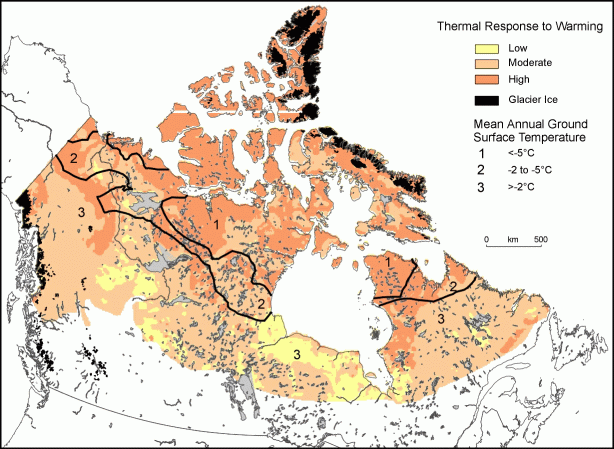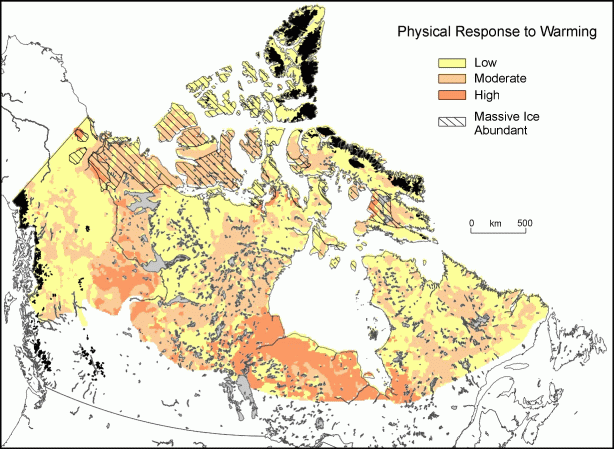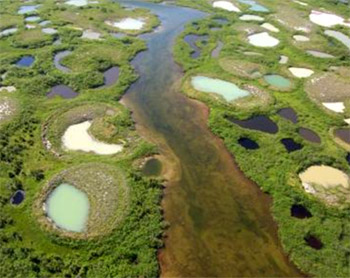The sensitivity of permafrost to climate warming is a component of a series of national syntheses of geological responses to climate change currently being prepared by the Geological Survey of Canada. The GSC study examines the sensitivity of permafrost to warming by considering the main factors that determine the response of the permafrost thermal regime to warming and the impact of any permafrost thaw that occurs. Geographic Information System (GIS) techniques have been used to produce maps classifying areas according to (A) the thermal response to warming: the relative rate and magnitude of ground temperature change (Figure 1), and (B) the physical response: the relative magnitude of the impact of permafrost thaw (Figure 2).

Click on map for larger image
Figure 1: The relative thermal response of permafrost to climate warming (from Smith and Burgess, 1998). Ground temperature has been classified into three zones. The potential for permafrost thaw would be greatest in areas underlain by permafrost that currently has a temperature close to 0°C (zone 3) and which also would exhibit a high thermal response to warming. Permafrost thaw and the disappearance of permafrost would be expected to occur first in these regions. (Image courtesy Sharon Smith, GSC).

Click on map for larger image
Figure 2: The relative physical response of permafrost to climate warming (from Smith and Burgess, 1998). Thaw subsidence will be greatest where ice-rich sediments are present. The structural ice content (pore ice and ice lenses) will generally be higher in fine-grained and organic material. In areas where massive ice is abundant the consequences of permafrost thaw could be more severe than indicated by the shading which reflects the structural ice content of the surficial material. (Image courtesy Sharon Smith, GSC).
Projected Changes in Canada

(Isabelle Laurion, INRS-ETE, QC).
A disequilibrium warming of permafrost is predicted in Canada, with surface permafrost layers thawing more rapidly. The top few meters of 16-20% of Canada’s permafrost is to be completely thawed by the end of the century. Additionally, the active layer throughout Canada is estimated to increase by 104% with extensive formations of taliks and a significant drop in the permafrost table depth (SWIPA, 2011).
The discontinuous permafrost in forested areas may experience very dry conditions in the future with thaw. Conversely, continuous permafrost zones may experience flooded conditions
(Figure 3). Supplementary wetland ecosystems could develop, altering current ecosystems. A release of higher than expected quantities of greenhouse gases (carbon dioxide, methane and nitrous oxide) is predicted to continue through this century. Moreover, permafrost structures degradation (Eg. Ice wedges) will destabilize ground surfaces. Inland slope failures and coastal erosion have already resulted from present thaw conditions (SWIPA, 2011).
Material for this page was provided by Margo Burgess and Sharon Smith, Geological Survey of Canada and Maren Pauly, Department of Geography, University of Waterloo.
